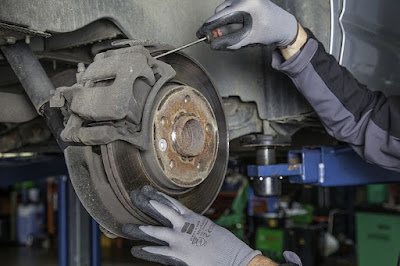Brake pads are a component of a vehicle’s braking system that are designed to create friction and slow or stop the vehicle’s movement. When the driver applies pressure to the brake pedal, the brake pads are pressed against the brake rotor or drum, creating friction that slows down or stops the vehicle. Brake pads are typically made of a durable material, such as ceramic or metallic compounds, that can withstand high levels of heat and friction. Over time, brake pads wear down and need to be replaced in order to maintain the safety and effectiveness of the braking system.
Brake pads are a wear and tear item that gradually wear down over time as they create friction against the brake rotors or drums. While brake pads do not typically fail on their own, there are a few situations that could cause brake pads to become damaged or fail prematurely:
- Overheating: If the brake pads get too hot, they can glaze over, becoming less effective at stopping the vehicle. Overheating can be caused by driving aggressively, riding the brakes, or towing heavy loads.
- Contamination: If oil, grease, or other contaminants get on the brake pads, they can become less effective or fail altogether. Contamination can occur if there is a leak in the engine or transmission, or if the brakes are improperly serviced.
- Wear and Tear: As mentioned earlier, brake pads are a wear and tear item that will eventually wear down over time. If the pads are not replaced in a timely manner, they can become too thin and fail to provide adequate stopping power.
Overall, brake pads are designed to wear out over time and require periodic replacement. While there are situations that can cause brake pads to become damaged or fail prematurely, it is important to properly maintain your vehicle’s brakes to ensure safe and reliable operation.
How to Replace Brake Pads
Replacing brake pads is a critical maintenance task that every car owner should know how to do. Brake pads are a key component of the braking system in your car, and they help to stop the car by creating friction against the rotors. Over time, brake pads will wear down and need to be replaced, which is why it is important to know how to do this procedure.
The Following Steps Outline How to Replace Brake Pads:
Step 1: Gather necessary tools and supplies
Before you begin, you will need to gather a few tools and supplies. You will need a jack, jack stands, a lug wrench, a C-clamp, a socket wrench, brake grease, and of course, new brake pads. Make sure you purchase the correct brake pads for your car, as there are different sizes and types available.
Step 2: Prepare your car for the job
Before you begin, park your car on a level surface and engage the parking brake. Loosen the lug nuts on the wheel that you will be working on, but do not remove them yet. Use the jack to lift the car off the ground, and place jack stands under the car for safety. Make sure the car is stable before continuing.
Step 3: Remove the wheel and old brake pads
With the car securely lifted and supported, remove the lug nuts and take off the wheel. Locate the brake caliper, which is typically located at the top of the brake rotor. Use a socket wrench to remove the bolts that hold the caliper in place. Once the caliper is loose, carefully remove it from the rotor. Be careful not to let the caliper hang by the brake line, as this can damage the line.
Next, remove the old brake pads from the caliper. They may be held in place with clips or pins. Take note of how they are positioned, as you will need to put the new ones in the same way.
Step 4: Prepare the new brake pads and caliper
Apply a small amount of brake grease to the back of the new brake pads, as this will help them to function smoothly. You may also want to clean the caliper and rotor with brake cleaner to remove any dirt or debris. Use a C-clamp to compress the piston in the caliper back into its original position. This will create enough space for the new, thicker brake pads.
Step 5: Install the new brake pads and caliper
Once the piston is compressed, slide the new brake pads into the caliper in the same position as the old ones. Reattach the caliper to the rotor, making sure the bolts are tightened securely. If the caliper has a brake line attached, be sure to position it carefully so that it is not pinched or damaged.
Step 6: Replace the wheel and test the brakes
Replace the wheel and tighten the lug nuts securely. Lower the car off the jack stands and remove the jack. Repeat the above steps for any additional wheels that need new brake pads. Once you have finished, start the car and pump the brakes a few times to make sure they are working properly.
Conclusion
In conclusion, replacing brake pads is a relatively simple procedure that can be done at home with the right tools and a little bit of knowledge. It is important to take your time and be careful when working with the brakes, as they are a critical safety component of your car. By following these steps, you can save money on brake repairs and ensure your car is functioning properly.











+ There are no comments
Add yours